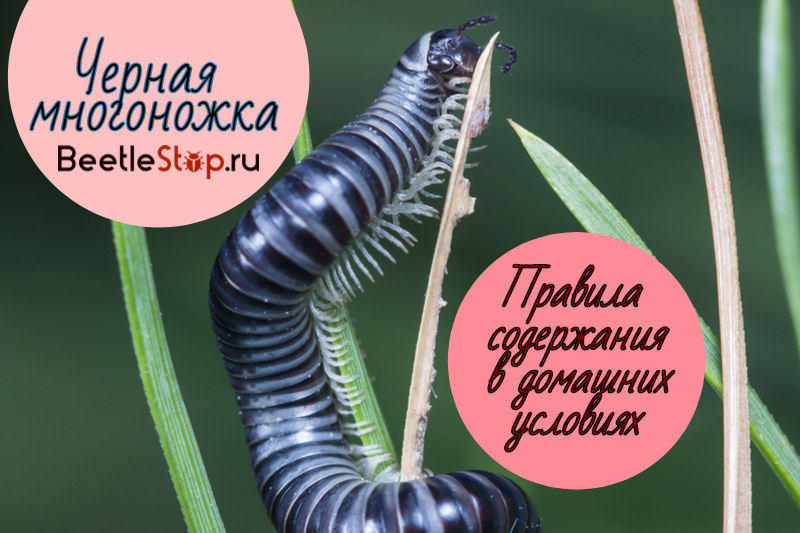Black millipedes - description, features of home care
In the ancient world, the length of millipedes reached 1.5-2 m. Modern representatives can not boast of such dimensions. The largest millipedes grow no more than 25-30 cm. The record holders include nipples. Despite its awesome appearance, the black millipede is a completely harmless creature. It feeds on organic residues, improves the soil and only in rare cases can damage the plant. Thanks to their original appearance, millipedes become pets and are kept in terrariums.

Biological features
Kivsyaki are ubiquitous. In European latitudes, these are medium-sized individuals 3-5 cm in length. The most interesting specimens live in eastern Africa in tropical and subtropical zones. Giant African millipedes resemble black long caterpillars with red legs.
Description of African nods
In the natural environment they live in forest litter, in the surface layers of the soil. In the substrate they are able to make winding moves. They can hide in burrows of rodents, small animals, between stones in tree trunks.
Characteristic features of black millipedes:
- Dark shiny or dull body color, mainly black with reddish and orange hues in adults, visually seems striped due to strong segmentation. The color of young individuals is not so saturated and most often gray.
- Pronounced head with antennae. On the sides are well-developed eyes. Mustaches perform the functions of smell and touch.
- Sizes from 3 to 28-30 cm. Sometimes larger individuals are also found. The most giant millipede is able to grow up to 35 cm, while the diameter of the body is about 6 cm.
- The body consists of many segments. Their number increases with age and varies from 15 to 90. The dorsal, ventral, lateral parts of each segment are fused into a single ring. The carapace is highly calcined, which provides reliable protection against mechanical influences.
- On each segment is a double pair of legs. Paws of red shades, their number depends on the age of the African nodule and can reach 400 pairs, which is why they are also called millipedes.
The life cycle of a black millipede is 7 years old, and under optimal conditions, a creature may even celebrate a tenth anniversary.
Features nutrition and vital activity of black millipedes
Black millipedes feed on fallen leaves, undecomposed organic matter. In case of depletion of food resources, they can leave the topsoil, in which they spend most of their lives and eat fallen fruits, green mass of plants, roots. If black nodding switched to a plant, then in most cases this ends with the death of the plantation, as a millipede bites the root.
Millipedes often absorb rotting wood from fallen trees, with species with a high calcium content being a priority.
Despite the abundance of legs, giant African millipedes move extremely slowly and awkwardly. In case of danger, they curl up and release a liquid that smells like iodine. It contains hydrocyanic acid, chloride compounds.For invertebrate animals, this secret is very dangerous; it causes redness and irritation in humans.
Kivsyaks have practically no natural enemies. According to the observations of biologists, the poison of African millipedes came to taste only to lemurs. The animals catch the worm-shaped creature and rub it on their hair, smearing themselves with fragrant liquid. European millipedes do not emit such a secret and become the prey of toads, frogs.
On African representatives of millipedes, ticks parasitize. It is widely believed that without these blood-sucking parasites, black nodules quickly die. However, those who keep centipedes at home have denied the version about ticks of symbionts. Without parasitic individuals, millipedes live and develop perfectly.
How do kivsyaki breed?
In giant African millipedes, maturity occurs at 4-5 years of age. Males differ from females in metallic luster, smaller size and the presence of gonopodia - a reproductive organ located on the 7th segment. Males are very gallant and mating is preceded by a romantic period. Males touch their females with their antennae. When she takes courtship, allows the gentleman to climb onto his back. In the process of hugs, the male passes the spermatophore - a kind of capsule with seminal fluid. Actually, this is the end of the pairing process.
A fertilized female builds a nest in the soil from its own excrement, soil, plant debris and lays eggs in it. After a few weeks, larvae appear from them.
The newly-minted individuals have only 6 legs located on 3 segments. The first time the larvae spend in the ground, eating the same as the parents. As they grow older, they molt and renew their carapace.
Home Conditions
African giant millipedes are becoming pets. If the creature is not squeezed or squeezed, it does not show aggression. On average, they grow by 4-5 cm per year. The acquisition of an exotic specimen will cost from 600 to 2500 rubles. Experienced terrarium workers recommend inspecting the purchase for ticks. If any are found, the black millipede is wiped with a cotton swab dipped in alcohol.
You can keep a centipede in an empty aquarium, a plastic container. The height is not as significant as the width, which should be at least twice the length of the body of the pet. How to care for a black nod:
- monitor the level of humidity (75-90%) and temperature conditions (23-29 ° С);
- feed with any plant food: slices of bananas, potatoes, mushrooms, lettuce, cabbage, etc., periodically sprinkle with chopped eggshell or calcium powder, add lime;
- substrate height within 7-10 cm, it should always be wet;
- giant african centipedes do not like bright light. Therefore, there is no need to bore yourself with planting plants in the terrarium.
Black millipedes do not require special care, adapting to new conditions and reaching the right age, will please their offspring.


 (votes: 2, average rating: 4,00 out of 5)
(votes: 2, average rating: 4,00 out of 5)